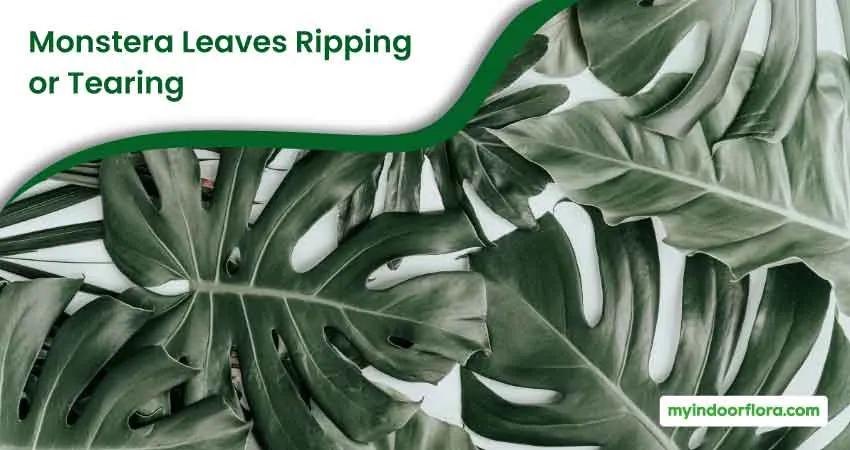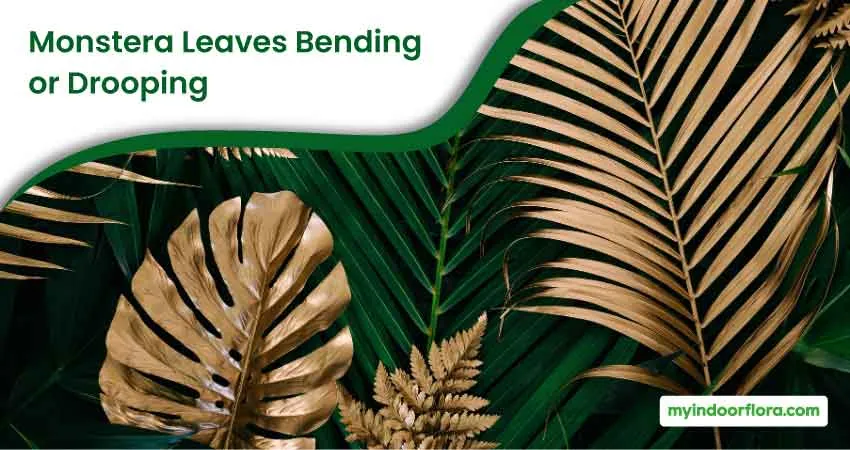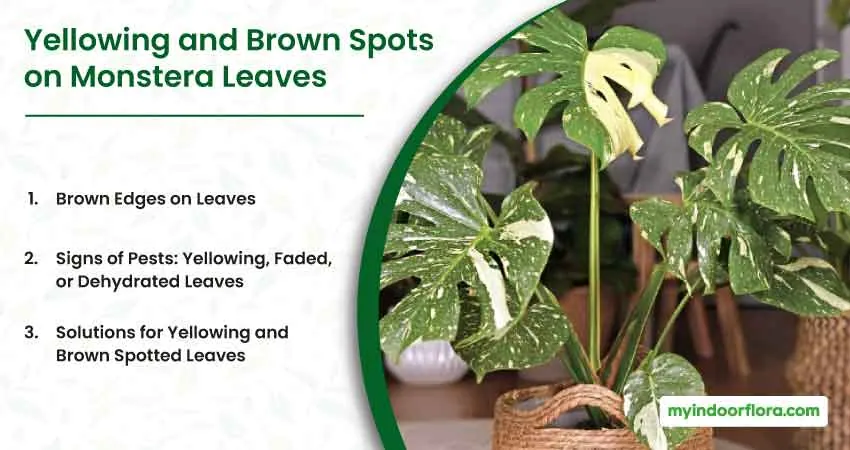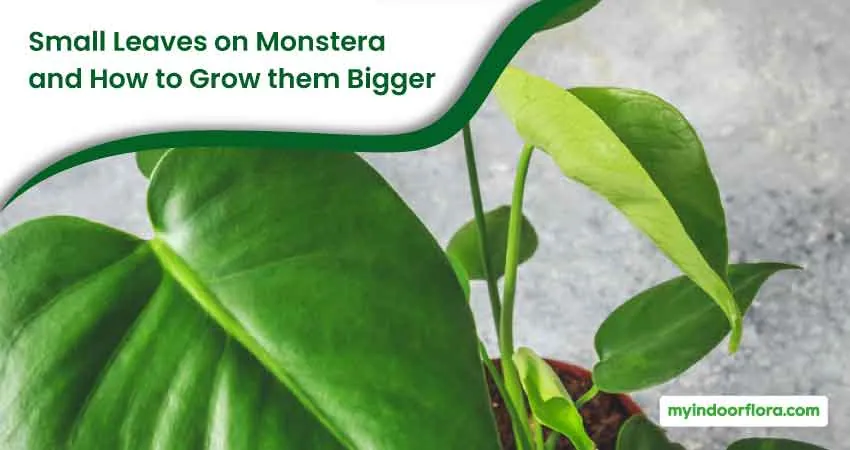Monstera plants, widely popular as houseplants, occasionally experience damage to their leaves. Despite their resilience, various factors can lead to issues such as ripped, torn, and bent leaves. Some of these concerns may not pose a significant threat, but it’s crucial to address others promptly.
To help you maintain a thriving Monstera deliciosa, we explore common causes of leaf damage and practical solutions for remedying these problems. Armed with this knowledge, you can confidently identify and tackle any leaf issues to ensure your beloved plant’s growth and longevity.
Key Takeaways:
- Understand potential causes of Monstera leaf damage, such as tearing and bending
- Identify and address concerning issues in a timely manner to promote plant health
- Learn effective solutions to maintain and revive your Monstera deliciosa houseplant
Monstera Leaves Ripping or Tearing
Monstera leaves are susceptible to mechanical damage, which is physical damage resulting from events like bumping into the leaf, pinching while moving, or even accidental collisions with objects or pets. As a Monstera owner, you may find leaves with tears or rips, but worry not, as it won’t significantly affect the overall health of your plant.
To protect your Monstera from further damage, place it in an area where the leaves won’t touch walls and are less likely to be bumped into. You can also ensure optimal humidity to keep the leaves less delicate and resistant to damage.

How To Deal With Ripping or Tearing
The decision of how to handle a Monstera leaf experiencing mechanical damage is entirely up to you. Your plant can still photosynthesize and function with an intact, damaged leaf; however, if it looks unsightly or begins to die off, you may choose to cut it off at the stem.
If you decide to cut off a damaged leaf near a node, make a clean cut and try propagating the leaf. Monsteras are easy to propagate, making it a good opportunity to encourage new growth. But, before cutting a damaged leaf, check for any new leaf growth on the same stem. In such a case, wait until the new leaf has fully unfurled before trimming the damaged one.
Keep in mind that the rips and tears in leaves won’t heal, but will remain as scars on the foliage. If a part of a leaf is ripped but still hanging on, carefully snip off the ripped section. The remaining part of the leaf will form a scab, and your Monstera will continue growing healthily.
Monstera Leaves Bending or Drooping
When your Monstera plant’s leaves and stems appear to droop or bend downward, it may be a sign of underwatering. This issue can be easily fixed as the plant will typically recover and look more vibrant after proper watering. It is advisable to water your Monstera consistently every 7-8 days, ensuring that the soil feels dry 1-2 inches down before watering.
Even with sufficient water, bending stems might indicate a need for more support in your plant. Introducing a moss pole in the soil can guide the stems to grow upward instead of outward. Also, make sure the pot size is appropriate for your plant. A young Monstera can manage in tight spaces for a while before repotting is necessary. However, an oversized pot may hold excess moisture, leading to overwatering and potential root rot.
Aside from watering, other factors to consider for your Monstera plant are humidity, temperature, and sunlight. Maintain a humid and bright environment with indirect sunlight to promote healthy growth—making use of a humidifier or placing the plant in an area with higher humidity levels can be beneficial. Keep your Monstera in a well-lit area but avoid direct sunlight to prevent wilting or curling leaves. Maintaining these conditions and paying attention to your Monstera’s needs will ensure that it continues to grow and thrive.

Yellowing and Brown Spots on Monstera Leaves
Brown Edges on Leaves
Brown tips on Monstera leaves may indicate that the plant is receiving too much sunlight or lacks sufficient humidity. For variegated Monstera varieties, such as Albo or Thai Constellation, extra caution is required since their white leaves are more sensitive to hot sun and dry air.
Signs of Pests: Yellowing, Faded, or Dehydrated Leaves
Inspect each leaf and stem thoroughly for any signs of pests. If you spot fungus gnats, tiny black flies buzzing around your plant, remove them immediately. While these gnats don’t typically cause significant damage to your plant, it’s crucial to address the issue promptly.
To control gnats, consider using natural methods. Additionally, examine the undersides of the leaves for scale bugs and spider mites. Scale bugs appear as smooth, brown bumps, while spider mites are tiny insects that produce fine webbing.
If pests are not an issue, tearing or drooping leaves on your Monstera may be due to the type of water you’re using. Tap water can sometimes be too harsh for plants because of its treatment. Switching to distilled or filtered water for a few months could potentially make a difference.

Solutions for Yellowing and Brown Spotted Leaves
- When yellowing or browning leaves result from overwatering, root rot, or fungal growth, inspect the roots and remove the damaged ones. Rinse the healthy roots with distilled water and repot the plant in fresh soil.
- Ensure that the soil mix provides adequate drainage and nutrients. A recommended soil mixture for Monsteras could be:
- ½ potting soil
- ¼ coco coir
- ¼ perlite
- A handful of organic fertilizer, like worm castings
- If leaves are severely yellow and lifeless, remove them with a sharp knife, cutting as close to the base of the stem as possible.
- For brown or black new leaves, it may indicate a fungus problem or persistently excessive water. Address the issue immediately to protect the overall health of your plant.
Broken Stems Of Monstera
When your Monstera stem breaks, it’s vital to remove it entirely. Utilize a sharp knife to cut it at an angle, as close to the base as possible. Keep in mind that the damaged stem won’t repair itself – it is beneficial for the plant to focus on new growth. Ensure proper soil, root, and stem support, as well as appropriate pot size, drainage holes, and potting soil mix (including perlite) when repotting to avoid future stem damage.

Small Leaves on Monstera and How to Grow them Bigger
If you notice that your Monstera’s leaves are smaller than usual, it might be due to several factors such as an inadequate pot size, insufficient light, low humidity, or depleted soil nutrients. To encourage bigger and more vibrant foliage, follow these steps:
- Repot your Monstera: If your plant has been in the same pot for more than a year, it’s time to find a slightly larger pot, a few inches wider and deeper than the current one.
- Change the soil: When repotting, replace the existing soil with a fresh mixture containing coco coir and perlite. This will ensure your Monstera has access to essential nutrients for optimal growth.
- Add a moss pole: Monsteras are naturally climbing plants, so providing a moss pole during repotting offers support for growth and helps them expand. As a result, your plant’s leaves should grow larger and healthier.
- Ensure adequate lighting: Place your Monstera near a window with bright, indirect light and a few hours of early morning or soft afternoon sun. Improved access to sunlight will boost photosynthesis and promote bigger leaves.
- Increase humidity: Monsteras thrive in humid conditions, originating from tropical climates. Use a plant humidifier or mist your Monstera daily to maintain moisture levels around the foliage.

By following these instructions, you’ll improve your Monstera plant’s growing conditions and help it develop larger, more attractive leaves. Keep monitoring the plant and adjust its environment and care routine as needed to maintain optimal growth.
Frequently Asked Questions
Why do Monstera leaves bend down?
How To Fix A Broken Monstera Stem?
1. Cut off the damaged stem below the break
2. Allow the cut surface to air dry for a day or two
3. Plant the cutting in fresh soil or water for propagation
Can a damaged Monstera leaf be propagated?
What causes Monstera leaves to rip?
Where to cut off a damaged Monstera leaf?
1. Locate the base of the leaf stem (near the main stem)
2. Use clean, sharp scissors or pruning shears to make a clean cut
3. Dispose of the damaged leaf properly to avoid attracting pests
